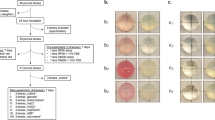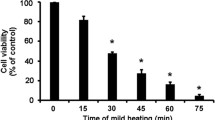Conclusion
After microwave irradiation the first change to occur in the lens appears to be a drop in the level of ascorbic acid. The depression in lens ascorbate does not occur immediately but is observed 6–18 hours after irradiation. Consequently, the loss in ascorbic acid does not appear to be a direct thermal effect. There is no corresponding change in the ascorbate level of the aqueous humor.
At a later stage after irradiation, when opacities first become visible, electrolyte and osmotic changes are also apparent. The degree of opacification of the lens seems to parallel the increase in electrolytes and water. Although no definite explanation has been established to account for these electrolyte and osmotic changes, the results suggest that lens permeability is increased by microwave irradiation.
Résumé
Après irradiation du cristallin avec des ondes ultracourtes le premier changement observable est une chute de la concentration de l'acide ascorbique cristallinien. La diminution de l'acide ascorbique n'est pas un phénomène immédiat après l'irradiation mais arrive 6 à 18 heures après. Pour cette raison on peut affirmer que cette diminution n'est pas un effet thermal. La concentration de l'ascorbate dans l'humeur aqueuse reste inchangée.
A un stade ultérieur quand les premières opacités se montrent on constate un changement de la concentration des electrolytes et de la pression osmotique. L'opacité du cristallin semble se développer parallèlement à l'augmentation des électrolytes et de l'eau dans le cristallin. Sans donner une explication définitive de ce phénomène il suggère l'hypothèse que l'irradiation avec des ondes ultracourtes augmente la perméabilité du cristallin.
Zusammenfassung
Nach Mikrowellenbestrahlung der Linse scheint die erste Veränderung der Abfall des Ascorbinsäurespiegels zu sein. Dieser Abfall erfolgt nicht sofort sondern 6–8 Stunden nach der Bestrahlung. Folglich scheint der Ascorbinsäureverlust nicht ein direkter thermischer Effekt zu sein. Auch kann man nicht eine entsprechende Änderung des Ascorbinsäurespiegels des Kammerwassers beobachten.
In einem späteren Stadium der Bestrahlung, wenn die ersten Trübungen sichtbar werden, beobachtet man auch Elektrolyt- und osmotische Veränderungen. Der Grad der Linsentrübung scheint der Zunahme von Elektrolyten und Wasser parallel zu gehen. Obwohl keine definitive Erklärung für diese Änderungen der Elektrolyte und des osmotischen Drucks gegeben werden konnten, sprechen die Resultate doch dafür, daß die Linsenpermeabilität durch Mikrowellenbestrahlung erhöht wird.
Similar content being viewed by others
References
Daily, L. Jr., K. G.Wakim, J. F.Herrick & E. M.Parkhill. The Effects of Microwave Diathermy on the Eye. Amer. J. Physiol. 155, 432 (1948).
Davson, H. & J. F.Danielli. Studies in the Permeability of Erythrocytes-Factors in cation permeability. Biochem. J. 32, 991 (1938).
— & E.Ponder. Studies on the Permeability of Erythrocytes. Biochem. J. 32, 756 (1938).
Carpenter, R. L. Experimental Radiation Cataracts Induced by Microwave Radiation. Proc. Second Annual Tri-Service Conf. on Biological Effects of Microwave Energy, Rome Air Div. Ctr., Air Res. and Dev. Command, Rome, N.Y., ARDC-TR-50–54, ASTIA DOC. No. AD 131–477, pp 146 (1958).
Carpenter, r. l., d. k. biddle & C. a. van ummersen. Opacities in the Lens of the Eye Experimentally Induced by Exposure to Microwave Radiation. IRE Trans. on Med. Electronics, ME-7, 152 (1960a).
Carpenter, r. l. Biological Effects of Microwave Radiation, with Particular Reference to the Eye. Proc. 3rd Int. Conf. Med. Electronics, 401, London (1960b).
Cogan, D. G., S. T.Fricker, M. Lubin, D. D.Donaldson & H.Hardy. Cataracts and Ultra-high-frequency Radiation. A.M.A. Arch. indust. Health, 18, 299 (1958).
Friedenwald, J. J. & D.Rytel. Contribution to the Histopathology of Cataract. A.M.A. Arch. Ophthal. 53, 825 (1955).
Harris, J. E. & L. Gruber. The Electrolyte and Water Balance of the Lens. Exp. Eye Res. 1, 373 (1962).
Kinoshita, J. H., H. L.Kern & L. O.Merola. Factors Affecting the Cation Transport of the Lens. Biochim. biophys. Acta, 47, 458 (1961).
— & L. O.Merola. Hydration of the Lens during the Development of Galactose Cataract. Invest. Ophthal. 3, 577 (1964).
— & C.Wachtl. A Study of C14 Glucose Metabolism of the Rabbit Lens. J. biol. Chem. 233, 5 (1958).
Roe, J. Chemical Determination of Ascorbic, Dehydroascorbic, and Di-Keto gulonic Acids, Methods of Biochemical Analysis. Vol. I. Interscience Publishers Inc., New York. p. 115 (1954).
Richardson, A. W., T. P.Duane & H. M.Hines. Experimental Lenticular Opacities produced by Microwave Irradiations. Arch. phys. Med., 29, 765 (1948).
von Sallmann, L., L.Caravaggio, P. Grimes & E. M.Collins. Morphological Study of Alloxan-Induced Cataract. A.M.A. Arch. Ophthal. 59, 55 (1958).
Williams, D. B., J. P.Monohan, W. T.Nicholson & J. J.Aldrich. Biologic Effects Studies on Microwave Radiation. A.M.A. Arch. Ophthal. 54, 863 (1955).
Author information
Authors and Affiliations
Additional information
A preliminary report of part of this study appeared in the Fourth Annual Tri Service Conference on Biological Effects of Microwave Radiation. 1, 285, 1960.
Howe Laboratory of Ophthalmology, Harvard Medical School and Massachusetts Eye and Ear Infirmary, Boston, Mass., and the Department of Biology, Tufts University, Medford, Mass.
Rights and permissions
About this article
Cite this article
Kinoshita, J.H., Merola, L.O., Dikmak, E. et al. Biochemical changes in microwave cataracts. Doc Ophthalmol 20, 91–103 (1966). https://doi.org/10.1007/BF00165408
Issue Date:
DOI: https://doi.org/10.1007/BF00165408




